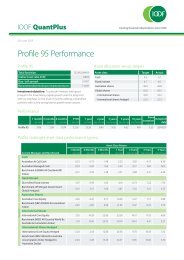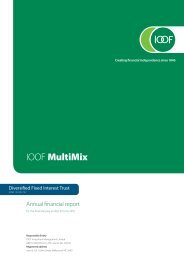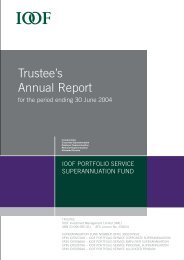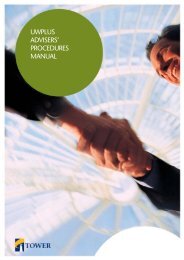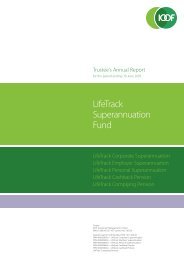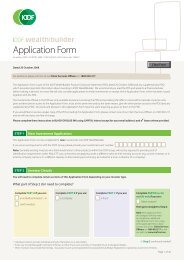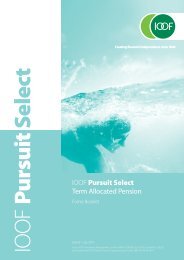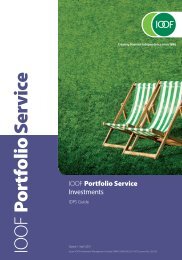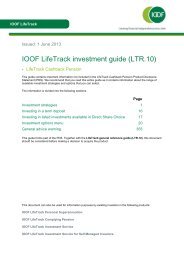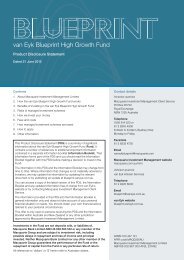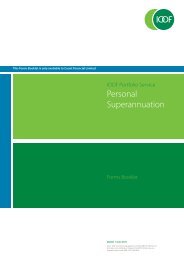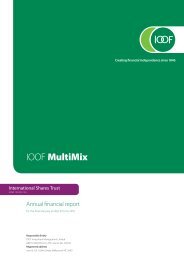annual report 2011
annual report 2011
annual report 2011
You also want an ePaper? Increase the reach of your titles
YUMPU automatically turns print PDFs into web optimized ePapers that Google loves.
IOOF | <strong>annual</strong> <strong>report</strong> <strong>2011</strong><br />
Notes to the financial statements (cont’d)<br />
For the year ended 30 June <strong>2011</strong><br />
Treasury shares<br />
Treasury shares are shares bought or transferred to the IOOF<br />
Executive Performance Share Plan Trust in respect of the<br />
employee share scheme. The Executive Performance Share<br />
Trust is controlled by the Group and is therefore consolidated.<br />
Capital risk management<br />
The Group’s and the Company’s objectives when managing<br />
capital is to safeguard their ability to continue as a going<br />
concern, so that they can continue to provide returns to<br />
shareholders and benefits to other stakeholders, and to<br />
maintain an optimal structure to reduce the cost of capital.<br />
In order to maintain or adjust the capital structure, the Group<br />
may adjust the amount of dividends paid to shareholders,<br />
return capital to shareholders, buy back its shares on market,<br />
issue new shares, sell assets, or otherwise adjust debt levels.<br />
The Group and the Company monitor capital on the basis of<br />
investment capital, working capital and regulatory capital.<br />
Investment capital is the Group’s capital that is not required for<br />
regulatory and working capital requirements of the business.<br />
The investment capital is invested in:<br />
• bank deposits<br />
• bank bills<br />
• subsidiaries<br />
• available-for-sale assets<br />
• unit trusts, as investments, and<br />
• Group operated unit trusts, as seed capital.<br />
Each subsidiary manages its own capital required to support<br />
planned business growth and meet regulatory requirements.<br />
Australian Prudential Regulation Authority (APRA) regulated<br />
subsidiaries have their own capital management plan which<br />
specifically addresses the regulatory requirements of that<br />
entity and sets a target surplus over minimum regulatory<br />
requirements. Regular monitoring of regulatory requirements<br />
ensures sufficient capital is available and appropriate planning<br />
is made to retain target surpluses. IOOF Holdings Ltd is<br />
primarily the provider of equity capital to its subsidiaries. Such<br />
investment is funded by IOOF Holding Ltd’s own investment<br />
capital, through capital issues, profit retention and, in some<br />
instances, by debt.<br />
Subsidiary capital generated in excess of planned requirements<br />
is returned to IOOF Holdings Ltd, usually by way of dividends.<br />
A standby facility is in place as a safeguard against a temporary<br />
need for funds and to provide a short term funding facility<br />
that allows the business to take advantage of acquisition<br />
opportunities as they arise.<br />
The weighted average cost of capital is regularly monitored.<br />
Funding decisions take into consideration the cost of debt<br />
versus the cost of equity with emphasis on the outcome that is<br />
best for shareholder interests.<br />
During <strong>2011</strong>, the Group’s capital risk management strategy was<br />
unchanged from 2010.<br />
Further information in relation to solvency requirements<br />
imposed by the Life Insurance Act is provided in note 40(h) Life<br />
Insurance Business – Solvency Requirements.<br />
The investment capital is available to support the organic<br />
development of new businesses and products and to respond<br />
to investment and growth opportunities such as acquisitions,<br />
as they arise. The seed capital is primarily available to support<br />
the business in establishing new products and is also used to<br />
support solvency requirements of the benefit funds.<br />
Working capital is the capital that is required to meet the day<br />
to day operations of the business.<br />
Regulatory capital is the capital which the Group is required to<br />
hold as determined by legislative and regulatory requirements<br />
in respect of its life insurance business and financial services<br />
licensed operations. During the year, the Group has complied<br />
with all externally imposed capital requirements to which it is<br />
subject.<br />
page 92



